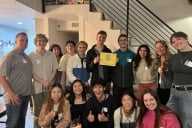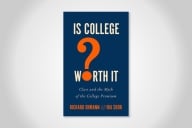You have /5 articles left.
Sign up for a free account or log in.
To address the greatest challenges in education, it’s imperative to ask the right questions. If you want to provide educators and learners with better value, ask them what problem they are trying to solve. Then determine what’s standing in their way and build a product or system that will delight them.
Last year, my colleagues and I at Cengage spoke with nearly 3,000 instructors across higher education to understand how we can better support them in being the best possible educators. Almost three-quarters of them told us that what they need most is high-quality content for their courses.
Their challenge? Historically, that content has come at a high cost to students. These costs have led to serious fallout -- one in five college students has skipped or deferred a class due to cost of course materials. Even more alarming: 27 percent of students never purchase course materials, which puts them at risk of low performance or failure. More than one in four students is not benefiting from the full potential of their educational experience.
The Promise of OER
The industry is ready for change. New models like Cengage Unlimited, an all-inclusive subscription for course materials, can significantly address the cost of materials. Similarly, open educational resources -- free and openly licensed educational materials -- have the potential to lower costs for students while also offering instructors freedom to customize course content. OER has been around for decades but recently has been gaining momentum as a resourceful way to provide less expensive options to students.
It’s also become prized for its flexibility: instructors using OER can tailor content to meet their needs -- changing it, remixing it or contributing their own content as they see fit to better meet the learning objectives of their students.
For instructors and students who prioritize affordability and flexibility, OER holds a lot of promise. However, when you look at how course materials are actually used by instructors and by students, it becomes clear that there are a few major hurdles that must be overcome in order for OER to provide value.
The Curation Issue
The most common challenge that instructors who want to use OER experience: it’s hard to find the best stuff.
OER quality is a mixed bag. Much of it is very good, but plenty of it isn’t. For instructors, parsing the quality of OER content and assessments takes time away from the countless other things they have to do to prepare their course. Forty-five percent of faculty members polled in a recent study said they couldn’t find quality OER resources for their subject areas.
With tens of millions of open educational resources available, how can an educator select and use OER effectively? Helping educators successfully implement OER requires that we solve the curation issue in a way that preserves what draws instructors to open content in the first place: its flexibility and affordability.
Ongoing Maintenance
A hard truth for instructors: maintaining OER is a full-time job.
Instructors who prize the quality of content find it time-consuming to update OER based on the latest scholarship.
Maintaining OER doesn’t just involve catching the odd inconsistency or updating the names of world leaders after an election. It means making sure that every piece of content is doing its job: helping students achieve the course’s learning objectives. Because OER doesn’t come with insights or support, instructors are on their own to make judgments about its effectiveness.
As you might expect, this adds up to a lot. Hidden expenses in curriculum development, assessments, record attributions, technology upkeep and compliance may require many hours.
While instructors and students benefit from the flexibility that OER provides -- the ability to change it, remix it, improve, contribute -- curating OER content is difficult and instructors are juggling any number of responsibilities in a given semester.
Solving the Challenges of OER
When you consider how much college students and their families are investing in higher education, it’s irresponsible for us to let students go without access to course materials that will help them succeed.
We must make it easier for instructors to curate and maintain OER, but it doesn’t end there. To make the impact of OER really powerful, we must give instructors the power to combine it with technology and instructional design principles. At Cengage, we’ve embraced OER to help instructors overcome the challenges of implementing open content to lower costs for students while providing them with high-quality materials that position them to achieve their goals.
Effective OER should be highly optimized and personalized to propel the learner toward success in the course. To do our part, we must help instructors curate OER and ensure it is continually maintained and safe to distribute. And, it is vital that we make it easier for instructors to tie OER content -- narrative and assessment -- to course learning objectives and curricula.
For too long, higher education has come with difficult choices. For instructors, that choice has been, “Do I want the low price of OER or the quality and reliability of curated content?” For students, it’s “Do I want to save money or do I want the best results?”
In fact, these aren’t choices. They’re constraints disguised as decisions. By opening the door to OER, we can remove barriers to learning so that instructors and students only have to make one choice: success.








